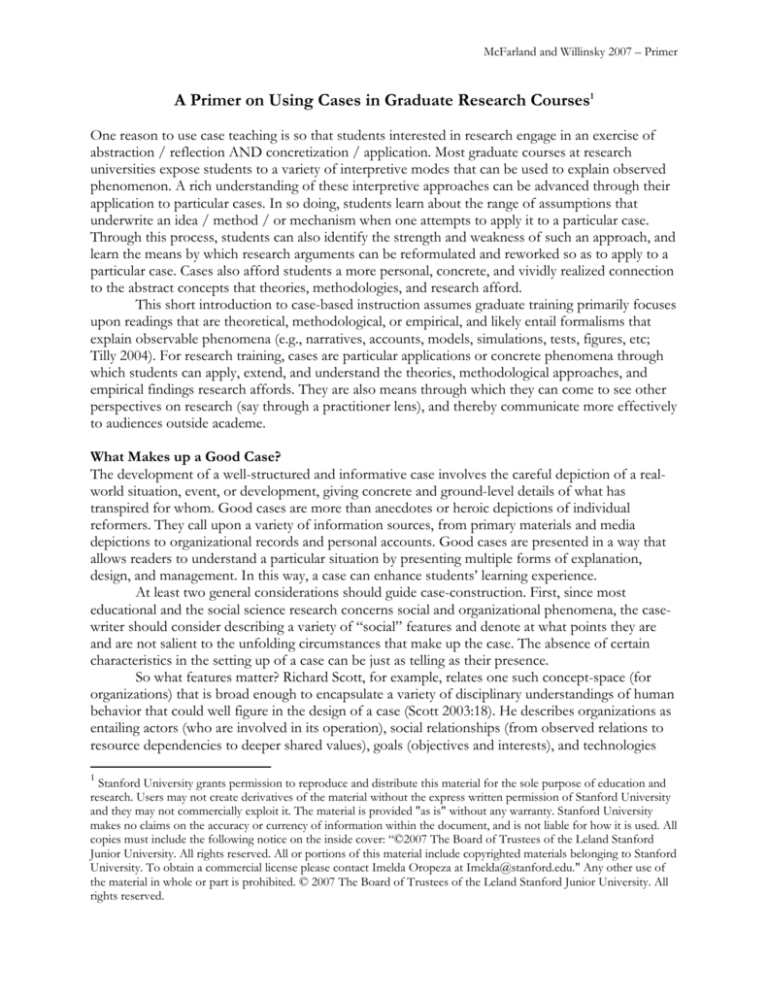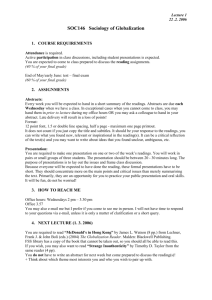
McFarland and Willinsky 2007 – Primer
A Primer on Using Cases in Graduate Research Courses1
One reason to use case teaching is so that students interested in research engage in an exercise of
abstraction / reflection AND concretization / application. Most graduate courses at research
universities expose students to a variety of interpretive modes that can be used to explain observed
phenomenon. A rich understanding of these interpretive approaches can be advanced through their
application to particular cases. In so doing, students learn about the range of assumptions that
underwrite an idea / method / or mechanism when one attempts to apply it to a particular case.
Through this process, students can also identify the strength and weakness of such an approach, and
learn the means by which research arguments can be reformulated and reworked so as to apply to a
particular case. Cases also afford students a more personal, concrete, and vividly realized connection
to the abstract concepts that theories, methodologies, and research afford.
This short introduction to case-based instruction assumes graduate training primarily focuses
upon readings that are theoretical, methodological, or empirical, and likely entail formalisms that
explain observable phenomena (e.g., narratives, accounts, models, simulations, tests, figures, etc;
Tilly 2004). For research training, cases are particular applications or concrete phenomena through
which students can apply, extend, and understand the theories, methodological approaches, and
empirical findings research affords. They are also means through which they can come to see other
perspectives on research (say through a practitioner lens), and thereby communicate more effectively
to audiences outside academe.
What Makes up a Good Case?
The development of a well-structured and informative case involves the careful depiction of a realworld situation, event, or development, giving concrete and ground-level details of what has
transpired for whom. Good cases are more than anecdotes or heroic depictions of individual
reformers. They call upon a variety of information sources, from primary materials and media
depictions to organizational records and personal accounts. Good cases are presented in a way that
allows readers to understand a particular situation by presenting multiple forms of explanation,
design, and management. In this way, a case can enhance students’ learning experience.
At least two general considerations should guide case-construction. First, since most
educational and the social science research concerns social and organizational phenomena, the casewriter should consider describing a variety of “social” features and denote at what points they are
and are not salient to the unfolding circumstances that make up the case. The absence of certain
characteristics in the setting up of a case can be just as telling as their presence.
So what features matter? Richard Scott, for example, relates one such concept-space (for
organizations) that is broad enough to encapsulate a variety of disciplinary understandings of human
behavior that could well figure in the design of a case (Scott 2003:18). He describes organizations as
entailing actors (who are involved in its operation), social relationships (from observed relations to
resource dependencies to deeper shared values), goals (objectives and interests), and technologies
1
Stanford University grants permission to reproduce and distribute this material for the sole purpose of education and
research. Users may not create derivatives of the material without the express written permission of Stanford University
and they may not commercially exploit it. The material is provided "as is" without any warranty. Stanford University
makes no claims on the accuracy or currency of information within the document, and is not liable for how it is used. All
copies must include the following notice on the inside cover: “©2007 The Board of Trustees of the Leland Stanford
Junior University. All rights reserved. All or portions of this material include copyrighted materials belonging to Stanford
University. To obtain a commercial license please contact Imelda Oropeza at Imelda@stanford.edu." Any other use of
the material in whole or part is prohibited. © 2007 The Board of Trustees of the Leland Stanford Junior University. All
rights reserved.
McFarland and Willinsky 2007 – Primer
(tasks and means of accomplishing said phenomena), and that these features are embedded in a
wider environment of other organizations. On this basis of this approach, a case can involve broadly
conceived notions of social phenomena, which afford different interpretations to be developed and
compared – from a rational actor perspective of a superintendent’s educational reform effort, to a
reform process primarily driven by the environmental pressures of a legal system. Whatever
approach is taken, the goal is to have a case that is broad enough in its description of circumstances,
factors, and ideas that it can give rise to multiple explanations and points of analysis can then be
productively compared and contrasted.
Second, a good case has a point of focus or hook. A general history is worthy in its own
right, but as a pedagogical tool, a case needs to hone in on a very specific set of closely related issues,
events, or changes. Hence, a case tends to concern a transition moment, crisis, or decision being
made that will be of some social relevance. In such a fashion, the case is vividly realized to reflect a
concrete reality, personal enough to strike a chord in students, and grand enough, with sufficient
import, to encourage students to consider broader implications.
How Can You Use Cases?
Perhaps the biggest issue confronting a faculty member is how to use cases in graduate research
training. This memo offers readers a few concrete ideas on how to use cases in their research
courses so that students identify more with the topics; engage more deeply in a process of
concretization – abstraction; and make them more active in the learning process.
For faculty, the first step to using a case entails preparation (Barnes et al. 1994). It is always a
good idea to read a case multiple times so you know the general story and the details. Since casebased instruction entails greater student participation and direction, the conversations can veer off in
a variety of unplanned and fruitful directions. Both a general understanding of the case and an eye
for its details will enable the instructor to adeptly facilitate such conversations.
When it comes to actually using a case, most lessons involve a sequence of different task
segments (see Foran:45): (i) begin the lesson by having a discussion with students about the case,
asking them factual questions about it so they recall the primary scene and soliciting what they found
fascinating, frustrating or otherwise interesting about the case, while sharing your own sense of it ;
(ii) use those responses to generate a particular dilemma or two concerning the case (problem, goal,
etc) that let’s them “inhabit” or grapple with how best to respond from the perspective of various
roles (administrator, researcher, etc.), whether as a class or in groups that role-play, debate, etc; (iii)
have a long analytic segment where the students, whether in reporting back on their group
discussions or summing up the class discussion, focus on the implications of their remarks for the
interpretive modes, theoretical models, and research findings found in the other course readings; (iv)
and, if you like, have an evaluative component where students reflect on the strongest and not-sostrong educational features of the case experience, providing constructive feedback on the case
experience. Whether the instructor moves through all the stages, uses groups or whole-class
discussions, the instructor and students should work hard to interrelate ideas expressed about the
case readings, course readings, and the personal understandings students have. That is, the
pedagogical focus needs to be on more than the circumstances and narrative represented by the
particular case.
Let us look at each type of segment and offer few ways they could be run.
1) Initial Discussion: think of simple questions to start the conversation and don’t be afraid to say
you are perplexed by how one would move forward in such a case, or that you had not before
this thought such a situation all the way through…
a. What happened in the case?
McFarland and Willinsky 2007 – Primer
b. What explains what happened in the case?
c. What would you do the same or differently in the case? Why?
d. What is the underlying process at work here? How does it work according to the
author’s narrative?
e. What is missing in the explanation? Where are the case’s biases and assumptions?
f. If you applied any one theory / method / study from the course readings to the case,
what would be the focus / explanation / explanation? Why? What features are
overlooked? What assumptions are revealed?
g. What do our theories and research suggest, in light of this particular case, about how
things work, that is, the process by which the events and phenomena unfurl?
h. What does this say about managing such a phenomenon?
2) You could vary the discussion opener and begin it with a quote. Find a passage in the case
reading (or even other course readings) that you think affords the best illustration of the case’s
main argument and lesson. Read it and ask what it means. Go from there and weave in questions
in (1) above.
3) Group work or whole-class exercise: Do the below, and facilitate student discussion. Then, well
before the end of class, call everyone together and have groups report back to the entire class.
Paraphrase what they say and ask them HOW they came to such decisions, what their thinking
was, etc. End with questions from (1) above that push them further into meta-level connections
across readings / ideas (how readings played a role in their decision / view; how case revealed
concrete instance of theory or its limits/strengths). Here are some ways to run group work:
a. Students apply course ideas and readings toward an analysis of the problem raised by the
case or its potential resolution.
b. Students role-play in groups (e.g., have them act as a commission of superintendents,
given X dollars, reviewing whether to renew a study).
c. Students engage in a semi-formal debate (e.g., have one group argue it is the content of
what is taught that matters over and above how it is taught, or that a shortage of
resources is or is not the causal factor).
d. Students prepare a brief research proposal which would result in additional needed
information that had the potential to move the case toward some form of resolution or
improved state.
e. Students devise a critique of the case, as itself a concrete representation of an education
issue, identifying biases, gaps, and the need for additional information, with this analysis
directed at improving the quality of the case in a way that can be utilized.
In sum, this is a brief memo that affords initial ideas on how a lesson can be organized using casematerials in a research-oriented program. They are not exhaustive, detailed, or even guaranteed to
work. They are just ideas to get you primed for case-based instruction.
References
Barnes, Louis B, C. Roland Christensen, and Abby J. Hansen. 1994. “Teaching and the Case
Method.” Harvard Business School Press.
Foran, John. “The Case Method and the Interactive Classroom.” The NEA Higher Education Journal,
pp. 41-50.
Scott, W. Richard. 2003. Organizations: Rational, Natural, and Open Systems (Fifth ed). Prentice Hall.
Tilly, Charles. 2004. “Observations of Social Processes and Their Formal Representations.”
Sociological Theory 22, 4: 595-602.







